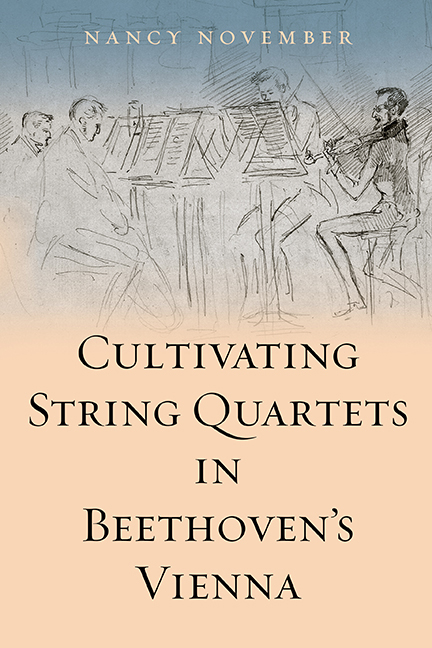Book contents
- Frontmatter
- Contents
- List of Illustrations
- List of Musical Examples
- Acknowledgements
- Introduction
- 1 Defining Chamber Music in the Early Nineteenth Century
- 2 Celebrating Haydn, Cultivating Opera
- 3 Selling String Quartets in Beethoven's Vienna
- 4 Locating String Quartets in Beethoven's Vienna
- 5 Early Nineteenth-Century Performance and Criticism
- 6 Sociability, Showmanship, and Study: ‘Quartet Friends’
- 7 The String Quartet and the Listener
- 8 Schubert's Song, Beethoven's Theatricality
- Epilogue: Constructing ‘Viennese Chamber Music’
- Bibliography
- Index
5 - Early Nineteenth-Century Performance and Criticism
Published online by Cambridge University Press: 16 May 2018
- Frontmatter
- Contents
- List of Illustrations
- List of Musical Examples
- Acknowledgements
- Introduction
- 1 Defining Chamber Music in the Early Nineteenth Century
- 2 Celebrating Haydn, Cultivating Opera
- 3 Selling String Quartets in Beethoven's Vienna
- 4 Locating String Quartets in Beethoven's Vienna
- 5 Early Nineteenth-Century Performance and Criticism
- 6 Sociability, Showmanship, and Study: ‘Quartet Friends’
- 7 The String Quartet and the Listener
- 8 Schubert's Song, Beethoven's Theatricality
- Epilogue: Constructing ‘Viennese Chamber Music’
- Bibliography
- Index
Summary
As we have seen in earlier chapters, concert life was slow to take off in Vienna in comparison with other major European capitals. But chamber music concerts developed more rapidly there, owing in large part to a group of middle-class enthusiasts – among them performers, composers, and writers – who championed the string quartet in particular. Music criticism was central to this development. Chamber music's move into a more public arena was heralded and aided by the emergence of a review culture, which took shape largely but not solely around the string quartet: a public forum was thus established for debate on the genre, its meanings, and its performers. Mutatis mutandis, the increasingly public and professional performance of string quartets provided a talking point that would help establish music criticism more generally. The multi-faceted discourse about string quartets shows the working-out of performance and compositional ideals that would, in the course of the nineteenth century, come to be used as a benchmark by which to canonise or marginalise other music.
This chapter examines the critical voices that were emerging on the subject of early nineteenth-century Viennese string quartets. The critical observations are drawn mainly from reviews of performances, which reveal a duality in the contemporary conceptions of the genre. The duality reflects a larger shift: conceptions of chamber music in general were changing from a predominately performance-based understanding to one based more on the composer and the ‘work’. But the new ‘work’-based concept was established first and foremost with regard to the string quartet. This becomes clear if one compares reviews of string quartets with those of other genres, especially other chamber genres.
Early Nineteenth-Century Music Reviews in Vienna
Reviews of string quartets, as compositions or in performance, were not numerous in the late eighteenth and early nineteenth centuries, but the pace began to gather during the nineteenth century, especially in connection with Schuppanzigh's quartet subscription concerts. Few Viennese journals of the early nineteenth century published music reviews at first. Indeed, only the Wiener Journal für Theater, Musik und Mode had a regular music review column, and it was short-lived: just twenty-four issues appeared, over the years 1805–06. This periodical and the longer-lived Wiener Theater-Zeitung (Vienna and Trieste, 1806; Vienna, 1807–08, 1811–60) are important sources for music criticism of the time, in the absence of a dedicated Viennese music periodical.
- Type
- Chapter
- Information
- Cultivating String Quartets in Beethoven's Vienna , pp. 121 - 146Publisher: Boydell & BrewerPrint publication year: 2017

